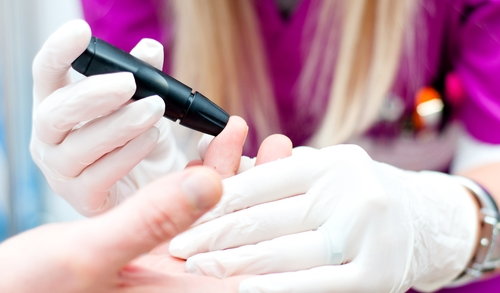Diabetes is a condition in which the body does not effectively use sugar. It is estimated that there are nearly 18 million Americans with diabetes, and approximately 15 percent of diabetics will develop a foot ulcer at some point. Foot ulcers are the most common wounds for this patient population.
Wound healing can be slowed when the patient is diabetic. An important point to remember about a diabetic patient wound is that it heals slowly and can worsen rapidly, so requires close monitoring. There are several factors that influence wound healing in a diabetic patient, and may include:
Blood Glucose Levels
It all starts here. An elevated blood sugar level stiffens the arteries and causes narrowing of the blood vessels. The effects of this are far-reaching and include the origin of wounds as well as risk factors to proper wound healing.
Poor Circulation
Narrowed blood vessels lead to decreased blood flow and oxygen to a wound. An elevated blood sugar level decreases the function of red blood cells that carry nutrients to the tissue. This lowers the efficiency of the white blood cells that fight infection. Without sufficient nutrients and oxygen, a wound heals slowly.
Diabetic Neuropathy
When blood glucose levels are uncontrolled, nerves in the body are affected and patients can develop a loss of sensation. This is called diabetic neuropathy. When there is a loss of sensation, patients cannot feel a developing blister, infection or surgical wound problem. Because a diabetic patient may not be able to feel a change in the status of a wound or the actual wound, the severity can progress and there may be complications with healing.
Immune System Deficiency
Diabetes lowers the efficiency of the immune system, the body's defense system against infection. A high glucose level causes the immune cells to function ineffectively, which raises the risk of infection for the patient. Studies indicate that particular enzymes and hormones that the body produces in response to an elevated blood sugar are responsible for negatively impacting the immune system.
Infection
With a poorly functioning immune system, diabetics are at a higher risk for developing an infection. Infection raises many health concerns and also slows the overall healing process.
Left untreated, infection can heighten the risk of developing gangrene, sepsis or a bone infection like osteomyelitis. According to statistics, diabetes is the number one reason for limb amputation in the U.S.
What You Can Do to Improve Healing
There are several things a patient can do to improve wound healing. The most important thing is to control the blood sugar level. Healing can be improved by taking these measures:
- Eating a healthy diet and maintaining good nutrition will help to regulate blood glucose levels and also provide the essential vitamins and nutrients to enhance the healing process. Adequate protein, carbohydrates and vitamin C intake are important factors to aid healing. Seek the advice of a registered dietician who specializes in diabetes, if necessary.
- Be aware of your body, especially if you experience diabetic neuropathy. Regularly check for open wounds or pressure points that could develop into a wound. Watch for signs of infection. Seek the medical attention of your primary care physician or other health care professional if you develop any areas of concern.
- Keep pressure off of a wound to aid healing.
- Chronic inflammation is a common symptom in many chronic diseases, including diabetes. By engaging in regular aerobic exercise, chronic inflammation can be reduced. Exercise lowers the blood sugar and also helps with weight management, another factor in keeping blood glucose levels controlled.
- Cardiovascular health is important to maintaining good circulation for both the healing of existing wounds and prevention of future wound development.
- Stop smoking to improve circulation and overall health.
The coordination of a multidisciplinary team of health care professionals to diagnose and treat a slow healing wound is critical to the overall health of a diabetic patient. Preventing the development of an open wound is important. Once a wound has manifested, it is critical to get the proper treatment plan in place as soon as possible.


